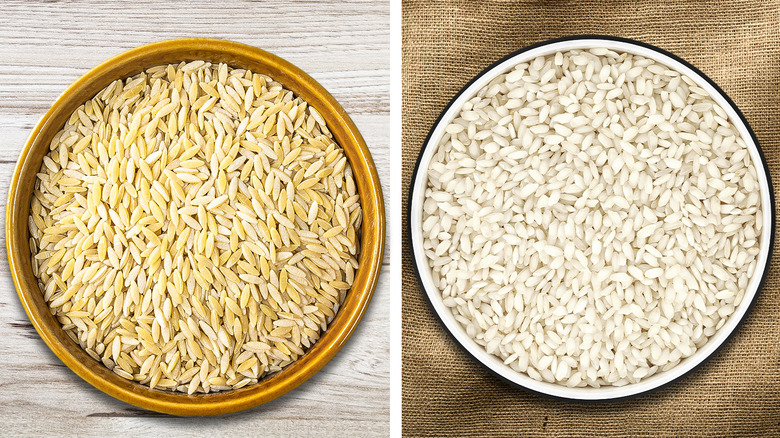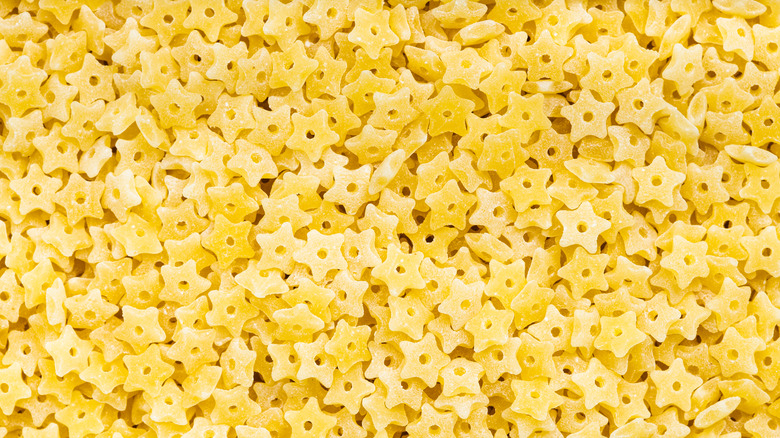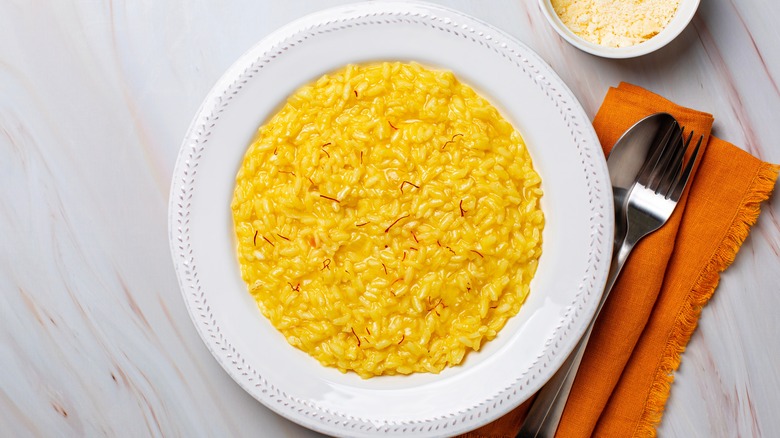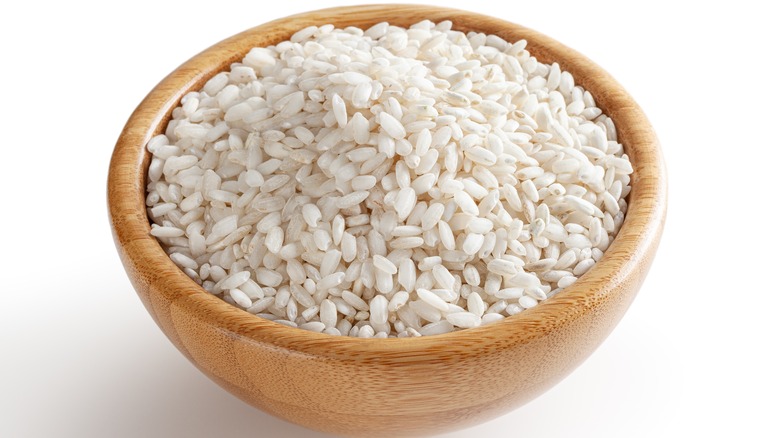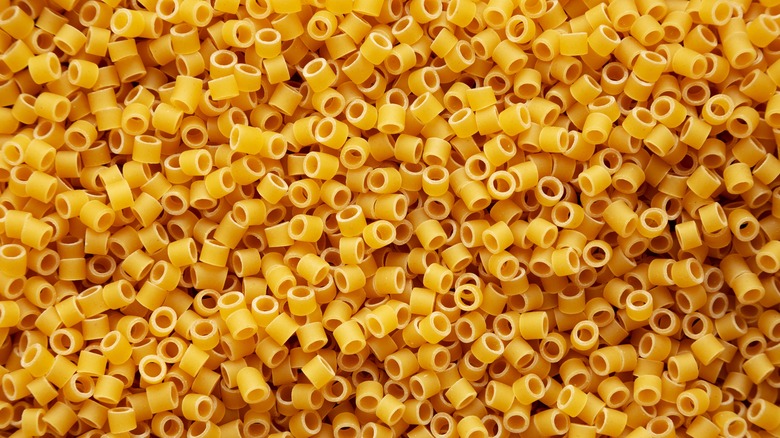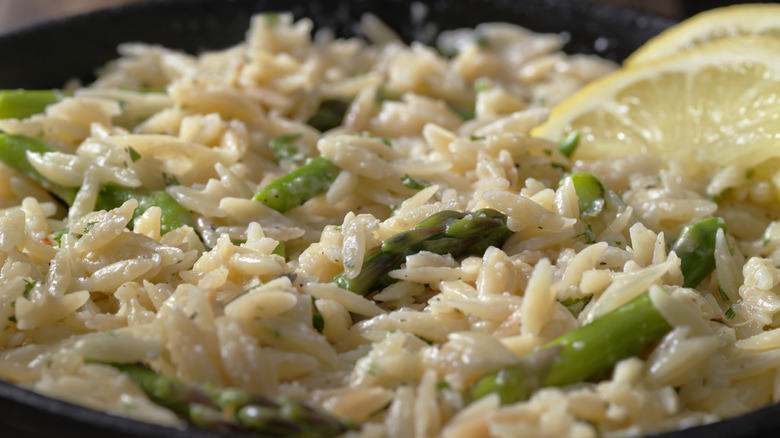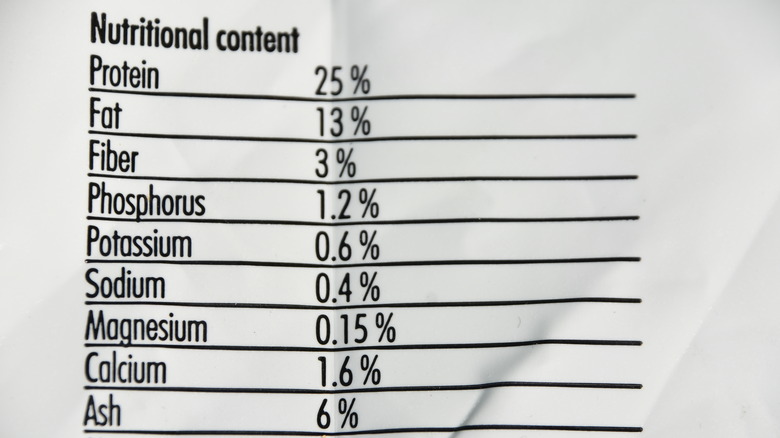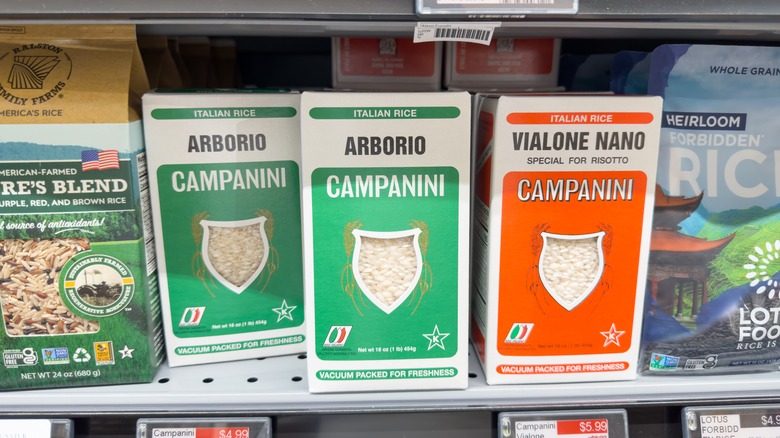The Major Difference Between Pastina And Risotto
Plates of pasta and fresh-fired pizzas may jump to mind when it comes to Italian cuisine — at least for most Americans. But when it comes to sumptuous, starchy dishes, the country boasts a bounty, from spongy focaccia to nutty, sweet polenta. Perhaps, though, the most elegant is the Northern Italian staple risotto, a carefully cooked concoction of short-grained rice, usually with wine broth, cheese, and other ingredients, that rewards those willing to put in the work with a luxurious, creamy, and hardy meal.
As with pasta, risotto variations are manifold, but the backbone of the dish is the rice, which slowly expels its starch into the cooking liquid while simultaneously absorbing it within its walls, becoming tender, but toothsome. Risotto, however, isn't the only foodstuff that can pull off this starchy swap. When slowly simmered in liquid, many different grains and pastas can pull off risotto's seemingly-magical transformation.
That fact has likely led some folks to confuse risotto with a lesser-known Italian dish: pastina. This infinitesimally small pasta comes in a multitude of shapes that can be added to soups or sauced like regular pasta. Pastina is cooked directly in a sauce, becoming highly risotto-esque. However, despite the shared traits, there are fundamental differences that set the two apart, with qualities and drawbacks to each that chefs should keep in mind.
What is pastina?
In the world of pasta, pastina stands out as a petite wonder. Available in various shapes like stars, tubes, and tiny shells, pastina adds whimsy to the culinary landscape. What sets it apart is its versatility — it can be added to soups, cooked like traditional pasta, or blossomed directly in a sauce, mirroring somewhat the technique employed in risotto preparation.
In the latter method, a sauce is prepared in a traditional fashion, but a bit more liquid, in the form of water, stock, or wine, is added to loosen it up a bit. Once it has come to a simmer, the pastina is added, and it begins to trade starch and liquid in a fashion not unlike risotto. The sauce reduces and thickens in the sauce, while the added liquid softens the pasta. Once the perfect balance is achieved, cheese and other ingredients like sausage and other proteins, vegetables, and herbs can be added to finish off the pastina.
What is risotto?
Risotto is an Italian dish that has transcended borders and delighted palates worldwide. Originating in Northern Italy, its history — at least in its most common form — dates back to the 1800s. At its most simple, risotto begins with onions sautéed in oil or butter to which the rice is added and allowed to toast. The wine is added and allowed to reduce and soak into the grains. Once that is accomplished, stock or broth is slowly incorporated, ladle by ladle, while the risotto is constantly stirred, slowly coaxing out the starch until the rice is tender and the sauce around it is thick.
The key to its luxurious texture lies in the rice used — primarily Arborio, though carnaroli and other varieties make for fine risotto — as well as how it is processed, or milled, after harvesting. Arborio's high starch content gives it a thick, creamy consistency when cooked. Compared to thinner long-grain rice, the stout, rounded grains of Arborio retain a bit of nuttiness and chewiness at their core. This provides risotto with the bit of bite characteristic of the dish.
Risotto is less processed
Risotto, a celebration of simplicity and wholesomeness, boasts delicately milled rice grains that retain their integrity. For arborio rice, the process begins with harvesting the grains and allowing them to dry under just the right conditions. This is to ensure a steady loss of moisture without damaging the kernels or rice. The husk is removed first followed by the bran, both of which encase the Arborio inside. The final product is a white, round grain of rice that still has plenty of starch to give.
On the other hand, pastina takes a different route, calling for milled durum semolina flour to be mixed with water and worked into a dough. The kneading and processing of the dough form gluten bonds that hold the pastina together when it is cooked. Once the dough is ready, it can be formed by hand or by extrusion from a machine to create a galaxy of different shapes and styles. The most common to Americans would be "stelline," or stars, but pastina comes as small balls, rice-like grains, ruffled curls, and dainty rings.
Pastina is less nutty than risotto
One of the defining characteristics of risotto is its nutty flavor, a result of a few different factors. First, the Arborio rice, though milled to remove the husk and bran, is still a largely unprocessed product. It still carries with it the flavor of natural Arborio, which can be a bit sweet and nutty. Second, to make a proper risotto, it is critical to toast the rice during the cooking process. This technique adds depth and complexity, as each grain of rice is bathed in butter or olive oil and picks up a bit of color from the hot pan. The nuttiness elevates the final dish and is contrasted with the acidic punch of wine added during the deglazing step.
Pastina offers a more neutral flavor profile. While there is a bit of nuttiness in the durum semolina flour, it is subtle. The flavor profile of pastina is more in line with its larger pasta cousins, with an unassuming taste that is the perfect backdrop for a variety of bold and piquant sauces and other more assertive ingredients.
Risotto can be a bit chewier than pastina
Texture plays a crucial role in defining the dining experience. Risotto, often cooked until al dente, offers a delightful chewiness. This is a factor of both the Arborio rice and the cooking method when executed properly. The rice itself has the perfect shape for cooking evenly while still leaving the faintest hint of undercooked rice residing at the center of the kernel. Of course, Arborio rice, as with any, can be overcooked, so it is important to follow the directions of any recipe to the letter and taste along the way for both seasoning and proper texture.
Pastina, though capable of being cooked al dente, is more commonly prepared all the way through. This results in a tender texture reminiscent of more traditional pasta dishes, providing comfort and familiarity. That being said, it shouldn't be assumed that pastina is typically insipid and mushy; rather, it should have a pleasant springiness much like that found in all properly-prepared pasta.
The nutritonal differences are slight
The choice between Arborio rice and pastina extends beyond flavor and texture to the nutritional benefits each brings to the table. Arborio rice presents a nutritional profile that aligns with its hearty nature. Per 100 grams, Arborio rice packs a caloric punch, making it a substantial source of energy. Beyond the energy boost, Arborio rice offers a modest but noteworthy amount of protein, contributing to the dish's overall satiating power. Carbohydrates, the body's primary fuel source, are present in abundance, making Arborio rice a wholesome choice for those seeking sustained energy.
On the other end of the spectrum, pastina, the petite pasta delight, boasts simplicity in both preparation and nutritional content. A roughly 100-gram serving of pastina provides a more modest caloric intake compared to Arborio rice, making it a versatile and lighter alternative. While it may be lower in calories, pastina still contributes to your daily energy needs. The nutritional simplicity of pastina extends to its protein and carbohydrate content, offering a balanced foundation for various culinary creations.
Expect to spend more for risotto
The culinary world often mirrors the economic reality, and the price difference between risotto and pastina is no exception. Arborio rice is a labor-intensive agricultural product that is sometimes harvested by hand, and as such, comes with a higher price tag. The careful milling process required to produce grains suitable for risotto contributes to its elevated cost as facilities, machinery, and personnel of the highest quality are needed to ensure an optimal grain. This results in Arborio rice generally wholesaling and retailing for twice the cost of more common long-grain rice varieties.
In contrast, pastina is made from readily available and relatively easily processed durum semolina flour and water. The dough is made alongside those for other pasta in often large operations that benefit from an economy of scale. Though there are undoubtedly artisan pastina makers who work by hand, most pastina found in stores relies on factory production and machines that can churn out copious amounts of diminutive shapes.
